
Drosera broomensis is a small, perennial carnivorous plant in the genus Drosera that is endemic to Western Australia. Its leaves are arranged in a small, leafy rosette, from which one to four inflorescences emerge. It produces white flowers in February and March. D. broomensis grows in sandy soils to the north and northeast of Broome in the Kimberley region. It was first described by Allen Lowrie in 1996, though earlier specimens from as early as 1891 had been collected. The specific epithet broomensis refers to the region in which it grows. It is closely related to Drosera petiolaris and differs from other related species by its glabrous inflorescence.

Drosera bulbosa, the red-leaved sundew, is a perennial tuberous species in the genus Drosera that is endemic to Western Australia. It grows in a rosette and produces white flowers emerge from April to June. D. bulbosa was first formally described by William Jackson Hooker in 1841.
Drosera fimbriata, the Manypeaks sundew, is a perennial tuberous species in the genus Drosera that is endemic to Western Australia. It grows to 10 to 15 cm tall with two or three whorls of non-carnivorous leaves on the lower portion of the stem and 2 to 5 whorls of carnivorous leaves above that. It is native to a region mostly around Manypeaks but with populations near the Scott River and near Denmark. It grows in winter-wet sandy soils in heathland. It flowers in October.
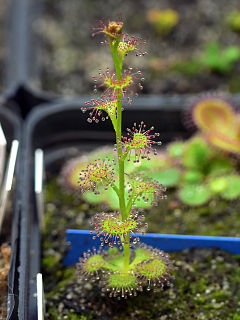
Drosera platypoda, the fan-leaved sundew, is a tuberous perennial species in the genus Drosera that is endemic to south-west Western Australia. It grows 15 to 20 cm tall with a basal rosette of leaves with alternate cauline leaves along the stem. It is native to a region from Manjimup south-west to an area around the Scott River and east to Cape Riche. It grows in winter-wet sandy soils in heathland. It flowers in October.
Drosera porrecta is a tuberous perennial species in the genus Drosera that is endemic to Western Australia. It grows up to 45 cm tall. It is native to a region from Eneabba and Marchagee south to an area around Pinjarra, including the Darling Range and Mount Cooke. It grows in well-drained sandy soils and flowers from July to September.
Drosera purpurascens is a compact tuberous perennial species in the genus Drosera that is endemic to south-west Western Australia. It produces 1 erect or 2 to 5 semi-erect lateral stems that grow to 3 to 10 cm long. The compact size of the plant combined with relatively long petioles distinguish it from all other members of the section Stolonifera. It is native to a region from Mount Cooke to near Katanning and Ongerup south to the Denmark-Albany region. It grows in sand-laterite soils and flowers from July to October, flowering en masse after bushfires.

Drosera ramellosa, sometimes referred to as the branched sundew, is a tuberous perennial species in the genus Drosera that is endemic to Western Australia. It was first formally described by Johann Georg Christian Lehmann in 1844. It was again described by Jules Émile Planchon as Drosera penduliflora in 1848, which was reduced to synonymy under D. ramellosa in 1864 by George Bentham.
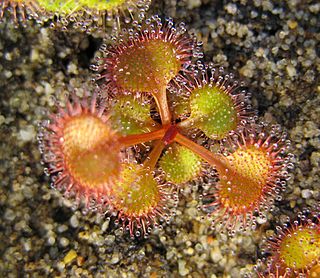
Drosera rupicola is a tuberous perennial species in the genus Drosera that is endemic to Western Australia. It produces 3 to 5 semi-erect lateral stems that grow up to 15 cm long. The turbinate tuber and mobile lamina that are capable of folding over prey distinguish it from all other members of the section Stolonifera. It is native to a large inland region from Pithara to south-east of Hyden. It grows in loamy soils near granite outcrops and flowers from July to October.
Drosera prostratoscaposa is a perennial tuberous species in the genus Drosera that is endemic to Western Australia. It grows in a rosette about 8 cm in diameter. It is native to a small area in the Fitzgerald River National Park 40 km south-east of the South Coast Highway in between Albany and Esperance. It grows in fine black sandy soils. It is considered to be closely related to D. macrophylla and D. bulbosa, but differs from these by the presence of multiple jasmine-scented flowers on its scapes and petiolate leaves.
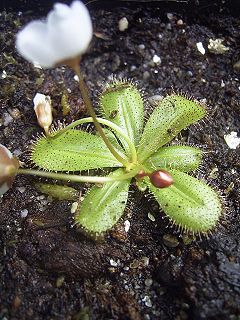
Drosera tubaestylis is a perennial tuberous species in the genus Drosera that is endemic to Western Australia. It grows in a rosette about 2 to 3 cm in diameter. It is native to an area near Perth. It grows in fine sandy clay soils at the margins of swamps. It is considered to be related to D. bulbosa. The species is named for the trumpet-shaped style apices. It was first formally described by Allen Lowrie and N. G. Marchant in 1992.
Drosera orbiculata is a perennial tuberous species in the genus Drosera that is endemic to Western Australia. It grows in a rosette about 1.5 cm in diameter. It is native to an area 1.3 km north of Gillingarra near Perth. It grows in sandy clay soils in winter-wet depressions and washes. It is considered to be related to D. rosulata. The species is named for the shape of the leaf lamina. It was first formally described by Allen Lowrie and N. G. Marchant in 1992.
Drosera lowriei is a perennial tuberous species in the genus Drosera that is endemic to Western Australia. It grows in a rosette about 3 cm in diameter. It is native to an area northwest of Esperance. It grows in loam soils in wet zones near granite outcrops. It is considered to be related to D. zonaria. It was first formally described by N. G. Marchant in 1992 and named in honour of Allen Lowrie.
Drosera browniana is a perennial tuberous species in the genus Drosera that is endemic to Western Australia. It grows in a rosette about 3 to 4 cm in diameter. It is a common species in an area from Mount Holland to Hatters Hill along the greenstone belt northwest of Esperance. It grows in loam soils in wet zones near granite outcrops. It flowers from August to September. It is considered to be related to D. bulbosa. It was first formally described by Allen Lowrie and N. G. Marchant in 1992 and named in honour of Andrew Brown, who discovered this species' first population.
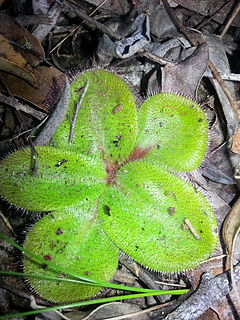
Drosera macrophylla, the showy sundew, is a perennial tuberous species in the genus Drosera that is endemic to Western Australia. It grows in a rosette with leaves 4 cm (2 in) long and 2 cm (1 in) wide. It is a common species east of Perth. It grows in loam soils. It flowers from June to October. D. macrophylla was first described by John Lindley in his 1839 publication A sketch of the vegetation of the Swan River Colony. In 1992, Allen Lowrie and Sherwin Carlquist described a new subspecies, D. macrophylla subsp. monantha, which is distinguished from D. macrophylla subsp. macrophylla by its single-flowered or rarely biflowered inflorescences. Subspecies monantha is abundant in the Bruce Rock/Merredin region.
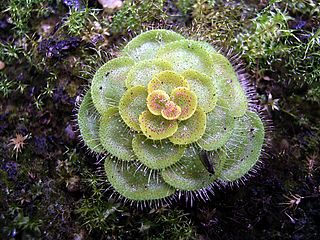
Drosera zonaria, the painted sundew, is a perennial tuberous species in the carnivorous plant genus Drosera and is endemic to south-west Western Australia from near Perth southeast to near Esperance. It grows in a tight rosette approximately 5 to 7 cm in diameter with 20 to 30 green to red leaves that are arranged in concentric layers. The leaves are typically 1 cm wide and are usually described as being "kidney-shaped" with crimson leaf margins. It grows in deep silica sands in open woodland or coastal heathland and only flowers after a bush fire, which is speculated to be caused by the release of ethylene. Its white, sweetly perfumed flowers, which are very similar to those of D. erythrorhiza, emerge on 4 to 5 cm tall scapes. As with most other tuberous Drosera species, D. zonaria will die back during the dry summer months and retreat to the fleshy tuber 10 to 30 cm below ground.

Drosera bulbigena, the midget sundew, is an erect perennial tuberous species in the genus Drosera that is endemic to Western Australia and occurs in an area near Perth and to its south along the coast. It grows to 3–6 cm (1–2 in) high and produces white flowers from August to October. D. bulbigena grows in swamps and winter-wet depressions.
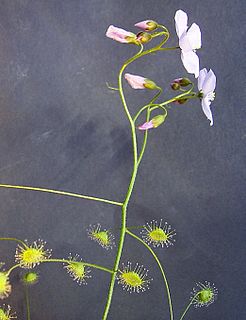
Drosera macrantha, the bridal rainbow, is a scrambling or climbing perennial tuberous species in the carnivorous plant genus Drosera that is endemic to Western Australia. It grows in a variety of habitats, including winter-wet depressions in sandy, loamy, laterite, or quartzite soils. D. macrantha produces small, cup-shaped carnivorous leaves along a long stem that can be 0.16–1.5 m (0.5–4.9 ft) high as it climbs. Its 1 in (2.5 cm) white or pink flowers emerge from June to November, blooming earlier in the more northern range.
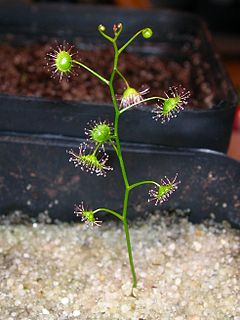
Drosera menziesii, the pink rainbow, is an erect or scrambling perennial tuberous species in the carnivorous plant genus Drosera. It is endemic to Western Australia and grows in a variety of habitats, including winter-wet depressions, swamps, and granite outcrops in clay or peat sand soils or loam. D. menziesii produces small, circular carnivorous leaves along an undulating erect stem that can be .05–1.1 m (0.2–3.6 ft) high. Its pink flowers emerge from July to November.

Drosera glanduligera, the pimpernel sundew, is a rosetted annual species in the carnivorous plant genus Drosera that is endemic to Australia. It is 2.5–6 cm (1–2 in) tall and grows in most soil conditions. It produces orange flowers from August to November. It was originally described in 1844 by Johann Georg Christian Lehmann. It is the sole species in the subgenus Coelophylla, which Jan Schlauer elevated from section rank in 1996; it was originally described by Jules Émile Planchon in 1848.

Australia has one of the world's richest carnivorous plant floras, with around 187 recognised species from 6 genera.












